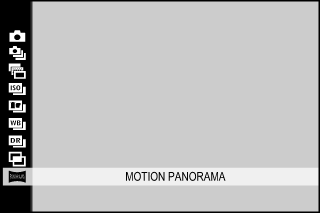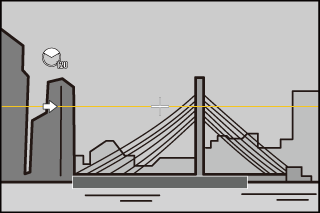Follow an on-screen guide to take photos that will automatically be joined to form a panorama.
Press the [DRIVE] button to display drive options.

Highlight [MOTION PANORAMA] and press [MENU/OK] to select the highlighted option and return to shooting mode.

To select the angle through which you will pan the camera while shooting, press the selector left. Press the selector up or down to highlight an angle and press [MENU/OK].

Press the selector right to view a choice of pan directions. Press the selector up or down to highlight a pan direction and press [MENU/OK].
Press the shutter button all the way down to start recording. There is no need to keep the shutter button pressed during recording.
Pan the camera in the direction shown by the arrow. Shooting ends automatically when the progress bar is full and the panorama is complete.

Shooting ends if the shutter button is pressed all the way down during shooting. No panorama will be recorded if the shutter button is pressed before the camera has been panned through 120°.
For Best Results
For best results, prop your elbows against your sides and move the camera slowly in a small circle at a steady speed, keeping the camera horizontal and being careful only to pan in the direction shown by the guides. Use a tripod for best results. If the desired results are not achieved, try panning at a different speed.
Panoramas are created from multiple frames; exposure for the entire panorama is determined by the first frame. The camera may in some cases record an greater or lesser angle than selected or be unable to stitch the frames together perfectly. The last part of the panorama may not be recorded if shooting ends before the panorama is complete.
Shooting may be interrupted if the camera is panned too quickly or too slowly. Panning the camera in a direction other than that shown cancels shooting.
The desired results may not be achieved with moving subjects, subjects close to the camera, unvarying subjects such as the sky or a field of grass, subjects that are in constant motion, such as waves and waterfalls, or subjects that undergo marked changes in brightness. Panoramas may be blurred if the subject is poorly lit.
When a panorama is displayed in full-frame playback, you can press the selector down to automatically pan from left to right or (if the panorama is in “tall” orientation) bottom to top.